Mailing List
Sign up for our mailing list to get latest updates and offers.
Thailand is a country rich in culture, history, and natural beauty, offering a diverse array of breathtaking sights for travelers. In Bangkok, the Grand Palace and Wat Pho showcase stunning architecture and spiritual significance, while the vibrant Chatuchak Weekend Market invites visitors to immerse themselves in local culture. A trip to Ayutthaya Historical Park reveals the ancient ruins of the former capital, and Doi Suthep in Chiang Mai provides both spiritual significance and panoramic views. The picturesque islands of Koh Phi Phi and Railay Beach are perfect for beach lovers and adventure seekers, while Phang Nga Bay captivates with its dramatic limestone karsts. Erawan National Park features the stunning Erawan Falls, ideal for swimming and relaxation. History enthusiasts will appreciate Sukhothai Historical Park and the poignant memorials in Kanchanaburi, including the iconic Bridge over the River Kwai. For a unique shopping experience, the floating markets, such as Damnoen Saduak, offer a taste of traditional Thai life. Lastly, the Similan Islands provide a paradise for snorkeling and diving. Whether exploring ancient temples, relaxing on pristine beaches, or experiencing vibrant festivals like Loy Krathong, Thailand promises unforgettable experiences for every traveler.

Grand Palace, Bangkok: The Grand Palace is a stunning architectural complex in the heart of Bangkok, historically serving as the royal residence of the Kings of Siam. Visitors are captivated by its intricate designs, ornate decorations, and vibrant colors. Within the palace grounds lies Wat Phra Kaew, home to the revered Emerald Buddha, a significant cultural symbol for Thais. The opulence of the palace reflects the rich history and artistry of Thailand, making it a must-visit for anyone exploring the capital.
Wat Pho, Bangkok: Just a short distance from the Grand Palace, Wat Pho is famous for its massive Reclining Buddha statue, which stretches 46 meters long and is adorned with gold leaf. This temple is also known as the birthplace of traditional Thai massage, and visitors can indulge in authentic massages at the on-site school. The serene atmosphere, intricate murals, and stunning architecture create a tranquil experience, making it a perfect complement to a day spent in the bustling city.
Ayutthaya Historical Park: A UNESCO World Heritage Site, Ayutthaya Historical Park is an extraordinary testament to Thailand’s rich history. Once the capital of the Kingdom of Siam, this archaeological park is dotted with impressive ruins of temples and palaces, such as Wat Mahathat and Wat Phra Si Sanphet. Visitors can explore the extensive grounds by bike or on foot, experiencing the unique blend of history and nature as trees intertwine with ancient stone structures, providing a glimpse into the grandeur of the past.
Doi Suthep, Chiang Mai: Perched on a mountain overlooking Chiang Mai, Wat Phra That Doi Suthep is one of Thailand’s most sacred temples. The golden stupa, adorned with intricate designs, is a significant pilgrimage site for Buddhists. The temple offers breathtaking views of the city and surrounding mountains, making the journey up the winding road well worth it. Visitors can also enjoy the serene atmosphere and learn about local Buddhist practices, deepening their understanding of Thai culture.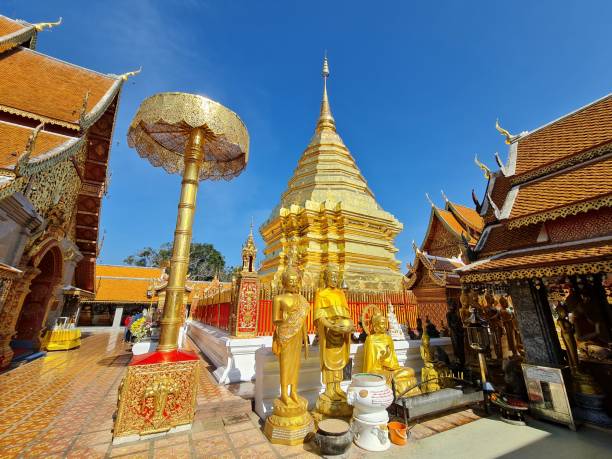
Chiang Mai Old City: The Old City of Chiang Mai is a charming area surrounded by ancient walls and a moat, filled with historical significance and beautiful architecture. Visitors can wander through narrow streets lined with traditional wooden houses and discover stunning temples like Wat Chedi Luang and Wat Phra Singh. The vibrant atmosphere is further enhanced by local markets and cafes, where travelers can taste authentic Northern Thai cuisine and experience the unique culture of the region.
Koh Phi Phi: The Phi Phi Islands are renowned for their breathtaking natural beauty, featuring crystal-clear waters, stunning beaches, and dramatic limestone cliffs. Koh Phi Phi Don, the larger island, offers vibrant nightlife, delicious dining, and water activities such as snorkeling and diving. A visit to the smaller Koh Phi Phi Leh, famously known for Maya Bay, provides opportunities to explore pristine beaches and vibrant marine life, making it a paradise for nature lovers and adventure seekers alike.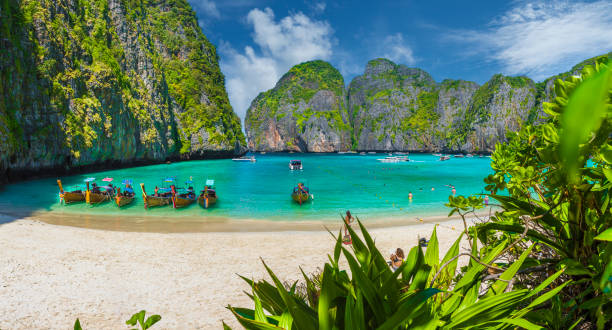
Phang Nga Bay: Phang Nga Bay is famous for its dramatic limestone karsts and emerald-green waters, creating one of the most picturesque landscapes in Thailand. Visitors can take a boat tour through the bay, exploring hidden lagoons and caves while visiting iconic spots like James Bond Island. The breathtaking scenery and unique geological formations make it a popular destination for photography and exploration, as well as a perfect spot for kayaking and relaxing in nature.
Erawan National Park: Known for its stunning seven-tiered Erawan Falls, Erawan National Park is a natural wonder located in Kanchanaburi. Hikers can trek through lush jungles, enjoying the beauty of the waterfalls and their inviting turquoise pools, perfect for swimming and relaxation. The park is home to diverse flora and fauna, making it an ideal spot for nature lovers. Visitors can spend a day exploring the trails, enjoying picnics by the falls, and immersing themselves in the serene natural surroundings.
Sukhothai Historical Park: As the first capital of Thailand, Sukhothai Historical Park is another UNESCO World Heritage Site that showcases the remarkable ruins of ancient temples and monuments. Visitors can explore the extensive grounds, where structures like Wat Mahathat and Wat Si Chum reflect the artistic achievements of the Sukhothai period. Biking around the park during sunrise or sunset offers a magical experience, as the golden light enhances the beauty of the ruins and creates a sense of tranquility.
Floating Markets: Thailand’s floating markets, such as Damnoen Saduak and Amphawa, offer a unique shopping experience where vendors sell fresh produce, local crafts, and delicious street food from boats. Visitors can glide through the canals, sampling authentic Thai snacks and immersing themselves in the vibrant atmosphere. The colorful boats and lively interactions between sellers and buyers provide a glimpse into traditional Thai life, making it a memorable and picturesque experience.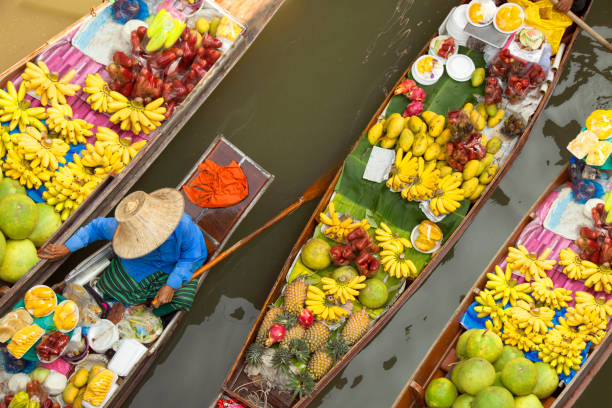
Railay Beach: Accessible only by boat, Railay Beach is famous for its stunning limestone cliffs, clear waters, and white sandy beaches. It’s a haven for rock climbers and beach lovers alike, with opportunities for both adventure and relaxation. Visitors can explore nearby caves, enjoy water sports, or simply bask in the sun on the beautiful beaches. The breathtaking scenery and laid-back vibe make Railay Beach a perfect getaway for those looking to unwind in paradise.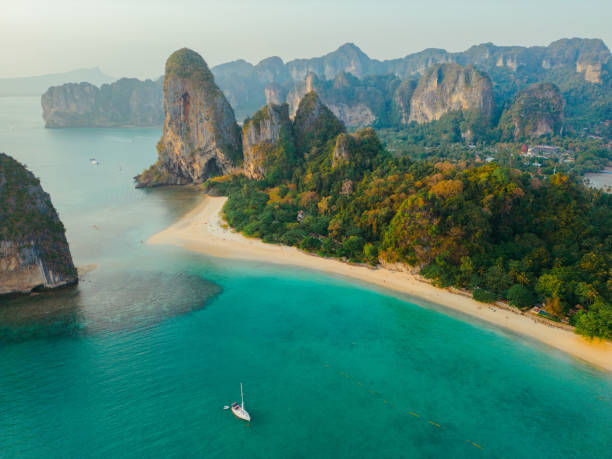
Bangkok's Chatuchak Weekend Market: One of the largest markets in the world, Chatuchak Weekend Market is a shopper's paradise, offering everything from clothing and home decor to food and souvenirs. With thousands of stalls and vendors, visitors can easily spend hours wandering through the vibrant alleys, sampling local delicacies like coconut ice cream and grilled meats. The lively atmosphere, combined with the variety of goods available, makes it a quintessential Thai experience not to be missed.
Similan Islands: The Similan Islands are celebrated for their stunning underwater biodiversity, making them one of the top diving and snorkeling destinations in Thailand. The crystal-clear waters, vibrant coral reefs, and diverse marine life attract divers from around the world. Visitors can explore the pristine beaches and partake in water activities, immersing themselves in the natural beauty of this national park. The islands' untouched landscapes and rich marine ecosystems offer an unforgettable experience for nature enthusiasts.
Kanchanaburi: Beyond the famous bridge, Kanchanaburi offers rich historical context and beautiful natural scenery. Visitors can explore the Hellfire Pass Memorial Museum, which commemorates the laborers who built the Death Railway during World War II. Additionally, the surrounding areas boast stunning waterfalls, such as Erawan Falls and Sai Yok Noi, perfect for day trips and relaxation amidst nature. Kanchanaburi provides a blend of history and adventure, making it a captivating destination.
Loy Krathong Festival: Celebrated annually, the Loy Krathong Festival is one of Thailand's most enchanting events. Participants create floating lanterns (krathongs) from banana leaves and flowers, releasing them into rivers and lakes as a way to pay respects to the water spirits. The sight of thousands of flickering lanterns lighting up the night sky is truly magical, drawing both locals and tourists. Experiencing this festival offers a unique insight into Thai culture and traditions, creating lasting memories.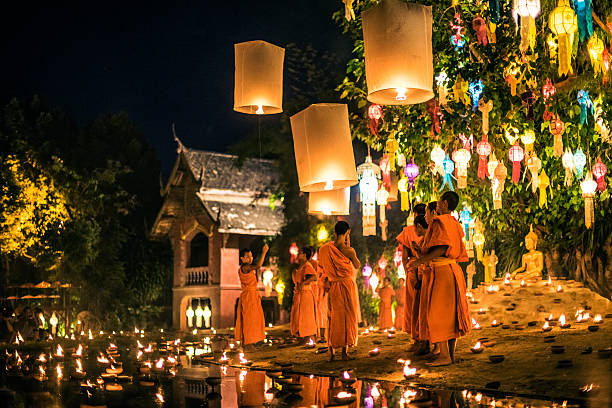
Thailand is known for its rich cultural heritage, deeply rooted in Buddhism, which influences many aspects of daily life. Traditional Thai customs include the famous "wai" greeting, where palms are pressed together in a gesture of respect. Festivals play a significant role in Thai culture, with notable celebrations like Songkran (Thai New Year) featuring water fights and Loy Krathong, where floating lanterns are released into rivers. Thai cuisine, renowned for its balance of flavors—sweet, sour, salty, and spicy—features dishes such as Pad Thai, Tom Yum Goong, and Green Curry.

Thailand is located in Southeast Asia, bordered by Myanmar, Laos, Cambodia, and Malaysia. It features a diverse landscape that includes mountainous regions in the north, fertile plains in the central region, and stunning beaches and islands in the south. The country is home to several national parks, including Khao Sok and Erawan, showcasing its rich biodiversity.
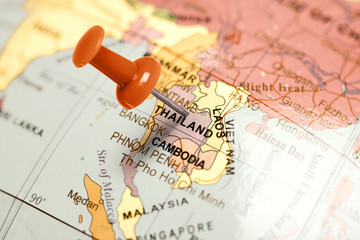
Thailand has a long and complex history, with influences from various kingdoms such as the Sukhothai and Ayutthaya. It was known as Siam until 1939, when it officially changed its name to Thailand, meaning "Land of the Free." Thailand is unique in that it was never colonized by Western powers, allowing it to maintain its cultural identity and traditions. The current monarchy, led by King Maha Vajiralongkorn (Rama X), continues to play a significant role in Thai society.

Thailand has a mixed economy, with agriculture, manufacturing, and tourism being key sectors. It is one of the world's largest producers of rice and exports a variety of goods, including electronics and automotive products. Tourism is a major contributor to the economy, attracting millions of visitors each year to its historical sites, natural beauty, and vibrant cities.
The official language is Thai, a tonal language with its own script. English is commonly spoken in tourist areas and among younger Thais, but learning a few basic Thai phrases can enhance your travel experience and interaction with locals.

Buddhism is the predominant religion in Thailand, practiced by about 95% of the population. The country is dotted with thousands of temples (wats), showcasing intricate architecture and vibrant decorations. While Buddhism is the main religion, there are also communities of Muslims, Christians, and other faiths.
Thailand is home to diverse wildlife, including elephants, tigers, and various marine species. Conservation efforts are ongoing to protect these species and their habitats, particularly in national parks and wildlife sanctuaries. Eco-tourism is gaining popularity, allowing travelers to experience Thailand’s natural beauty while supporting conservation initiatives.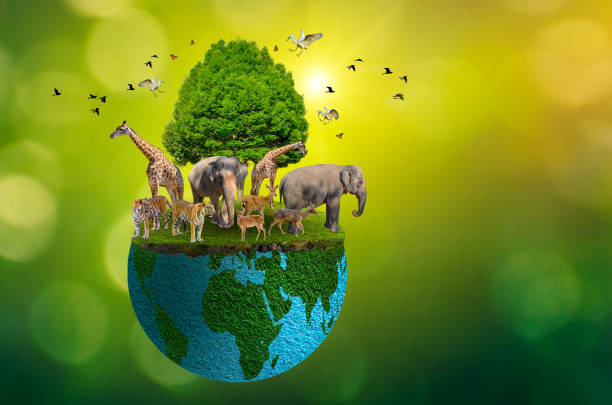
Thailand has a tropical climate characterized by three main seasons: hot (March to May), rainy (June to October), and cool (November to February). The best time to visit is during the cool season when temperatures are more moderate and rainfall is minimal.
Thailand has a well-developed transportation network, including domestic flights, trains, buses, and ferries. In cities like Bangkok, the BTS Skytrain and MRT subway offer efficient public transport options. Tuk-tuks, motorbike taxis, and songthaews (shared taxis) provide local transportation, adding to the vibrant urban experience.
Thai people are known for their warmth and hospitality, often referred to as the "Land of Smiles." Visitors frequently note the friendly demeanor of locals, making travel in Thailand a welcoming experience.
Thailand is known for its strong cultural traditions that are woven into everyday life. Festivals are a key aspect, with Songkran (Thai New Year) celebrated in mid-April with massive water fights symbolizing the washing away of sins and bad luck. Loy Krathong, celebrated in November, involves floating decorated baskets on water to pay respect to the river spirits. Additionally, traditional dances and ceremonies often take place at local temples, showcasing the country’s rich heritage.

Thai cuisine is celebrated worldwide for its bold flavors and fresh ingredients. Key components include:



Thai arts and crafts are renowned for their intricate designs and craftsmanship. Traditional crafts include:



Buddhism is central to Thai identity, shaping societal values and customs. The country is home to thousands of temples, each with unique architecture and history. Important temples include:




Thailand is one of the most popular tourist destinations in the world, attracting millions of visitors annually. Key tourist attractions include:
Thailand’s diverse ecosystems include tropical rainforests, mountains, and coastal regions, supporting a rich array of wildlife:


Thailand has a diverse economy, with tourism being a significant sector. Other key sectors include:
Thailand places a strong emphasis on education, with both public and private institutions available. The education system includes primary, secondary, and higher education levels, with a growing number of international schools and universities catering to expatriates and locals alike.

In recent years, Thailand has seen significant urban development and modernization, particularly in cities like Bangkok. Skyscrapers, shopping malls, and improved infrastructure reflect the country’s rapid growth while still preserving its cultural heritage.

The currency of Thailand is the Thai Baht, abbreviated as THB. Here are some key points about the Thai Baht:
The ideal duration for a travel package to Thailand can vary based on your interests and the regions you want to explore. Here’s a breakdown of suggested durations for different types of trips:
Best for: A quick getaway focused on Bangkok and nearby attractions.
Best for: A balanced trip with more cultural experiences.
Best for: A comprehensive experience covering multiple regions.
Best for: In-depth exploration of Thailand’s culture, nature, and beaches.
You can adjust the number of days based on:
